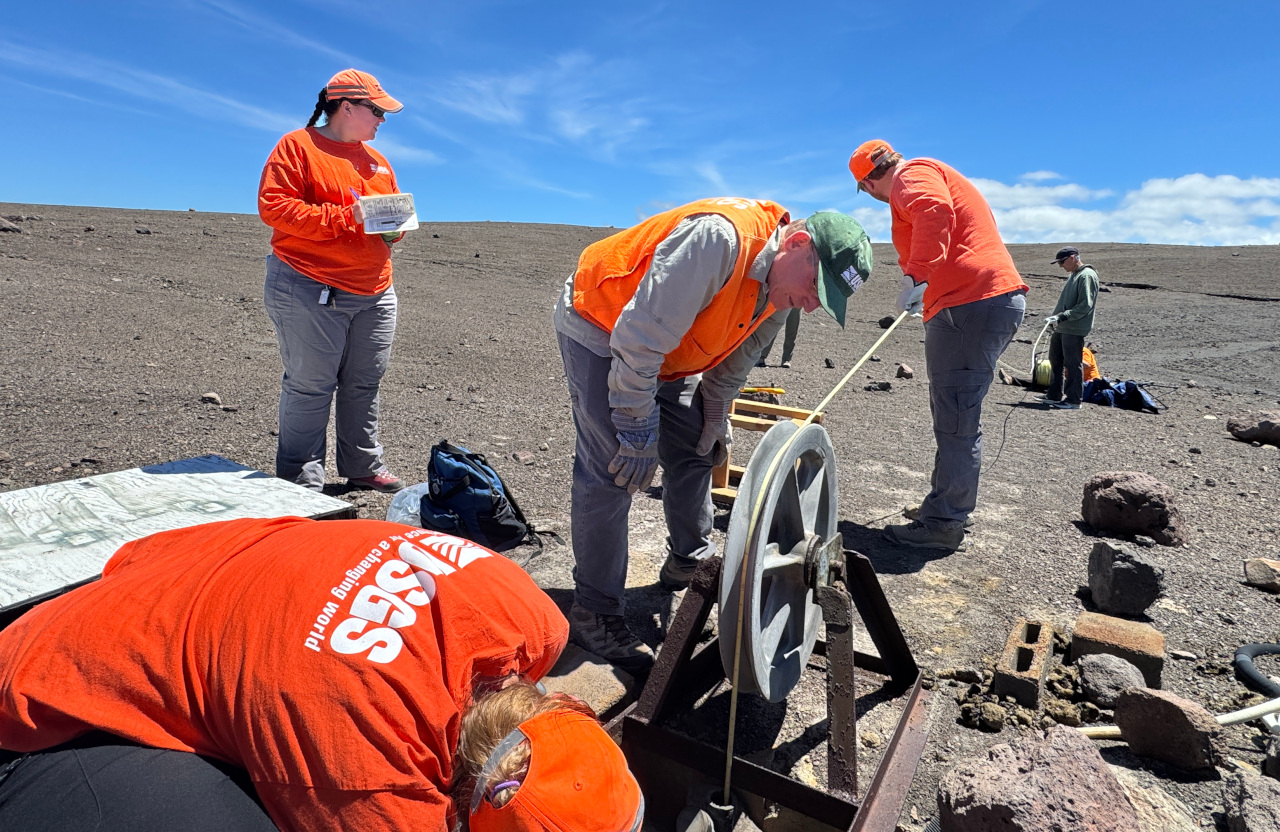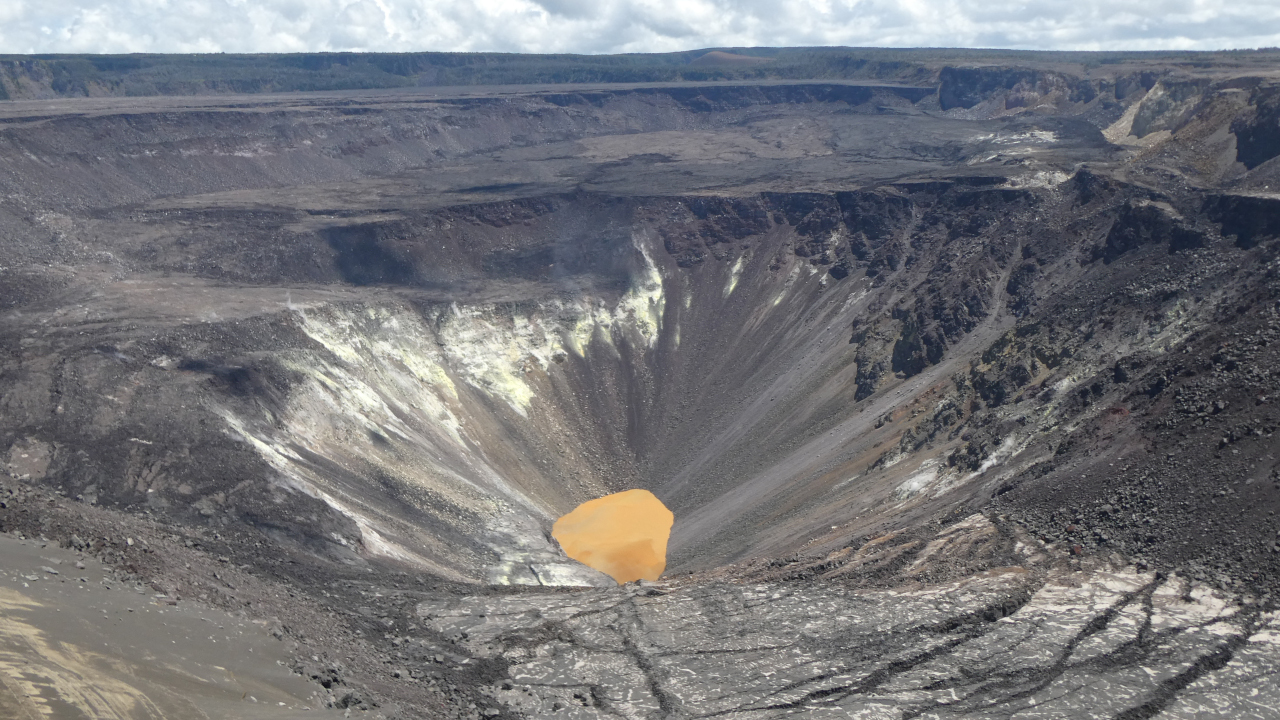(BIVN) – The ongoing eruption at the summit of Kīlauea is paused, with the next episode of lava fountaining expected next week.
The USGS Volcano Alert Level for Kīlauea remains at WATCH.
In this week’s Volcano Watch article, USGS California Volcano Observatory research hydrologist Shaul Hurwitz writes about how water plays a role in Kīlauea eruptions:
When most people think of erupting water, they probably have geysers, like Old Faithful Geyser in Yellowstone National Park, in mind. However, Kīlauea and its diverse style of eruptions are also significantly impacted by water. In fact, some of Kīlauea’s past explosive eruptions occurred when magma erupted through groundwater or through a lake in a summit crater.
Water (H2O) that originates from the atmosphere—including snow and rain—is called “meteoric water.” The large amounts of rain in and around Kīlauea seep into the ground (rather than flow in streams) because the shallow basaltic rocks of Kīlauea have very high permeability, meaning that a lot of water can flow through them. When the water is beneath the ground, it is called groundwater.

USGS: “On July 25, 2025, USGS scientists measured the depth to the water table at the Keller Well, located south of Halema‘uma‘u crater. The Keller Well is a borehole drilled in 1973 to a depth of 4,140 ft (1,262 m); since then, it has been used to monitor the hydrology of the summit region of Kīlauea volcano.” (USGS photo by K. Mulliken)
Measurements made for more than two decades in a deep well on Kīlauea’s summit have provided information on the depth of groundwater, and it is deep! Until the 2018 eruption, water level in the well varied between about 1600 and 1620 feet (488–494 meters) below the ground surface. After the 2018 eruption, water in the well dropped to about 1660–1670 feet (506–509 meters). This is about 2400 feet (740 meters) above sea level. Chemical analysis of water from the well has informed scientists how much gas emitted from the magma is absorbed by groundwater. Although the water in the well contains significant amounts of sulfur and chlorine that are from the magma, the water itself is predominantly meteoric.
Another, albeit short, glimpse into Kīlauea’s groundwater came from sampling a water lake that filled the Kīlauea summit crater between July 2019 and December 2020. That lake was mostly filled by groundwater flowing from the surrounding rocks. To know what was in the water, HVO scientists collected samples using drones (or UAS, or Uncrewed Aircraft Systems). Chemical analysis of the water revealed that it was very saline (about twice the salinity of seawater) and contained a lot of sulfur. However, the sulfur in the lake was not derived from gas released by an underlying magma but from leaching of minerals containing sulfur (sulfate minerals). At that time (2019–2020), that inference suggested a small likelihood of an explosive phreatomagmatic eruption (an eruption that occurs when magma interacts with external water).
FILE VIDEO from October 2019: USGS Kilauea Volcano Water Pond Update: Observations & Potential Dangers
Although most of the water below ground is meteoric, small amounts of water are also dissolved in deep magma—similar to carbon dioxide (CO2) being dissolved in carbonated drinks. When the magma moves closer to the ground surface and the pressure on the magma decreases, water (and other gases) is released from the magma. The water released from the magma is either emitted to the air as a gas plume (with the other gases, such as sulfur dioxide), or it mixes with meteoric groundwater. The process is like opening a bottle of soda that causes the CO2 to be released from the liquid, form bubbles, and escape from the bottle.
Most measurements of gas emission in Kīlauea are focused on determining the amount of sulfur dioxide (SO2) but the most abundant gas in the plume is actually water (as steam). On average gas plumes in Kīlauea contain about 90% water. How do scientists know that? By measuring the concentrations of gas samples collected from high temperature fumaroles and from remote measurements with an instrument called Fourier Transform infrared spectrometer (FTIR) that can measure the relative abundance of some gases, including those of SO2, CO2, hydrogen chloride (HCl), and water.
Water is a key ingredient in all volcanoes. At Kīlauea, water has a significant impact on the explosivity of the eruptions, on the texture of erupted rocks, and on the amounts and compositions of gases emitted. Kīlauea’s continuous evolution is controlled by many factors and water is one of the most significant.
For further reading: Groundwater Dynamics at Kīlauea Volcano and Vicinity, Hawaiʻi. In U.S. Geological Survey Professional Paper 1867.


by Big Island Video News7:58 am
on at
STORY SUMMARY
ISLAND OF HAWAIʻI - At Kīlauea, water has an impact on the explosivity of the eruptions, the texture of erupted rocks, and on the amount of gas emitted.